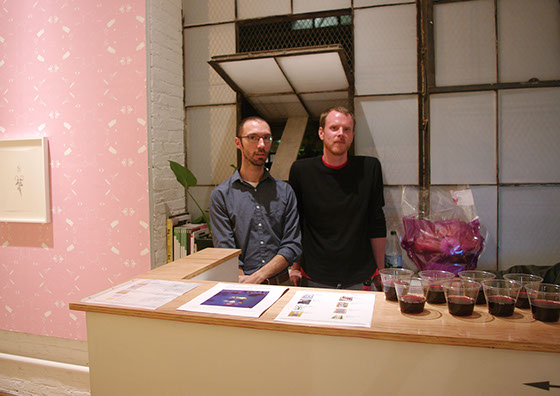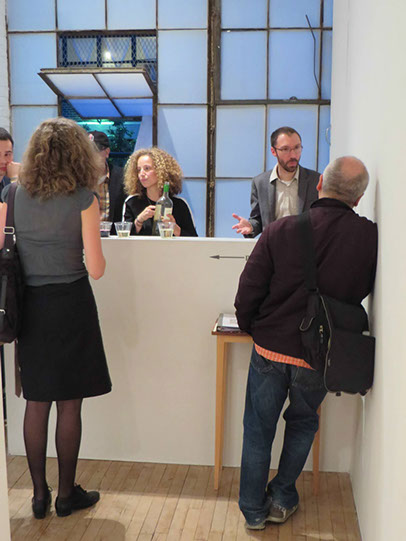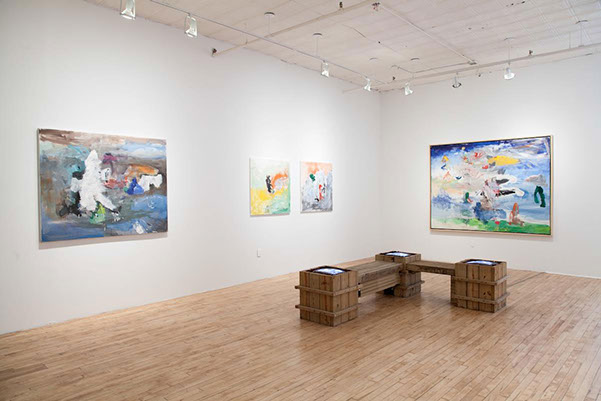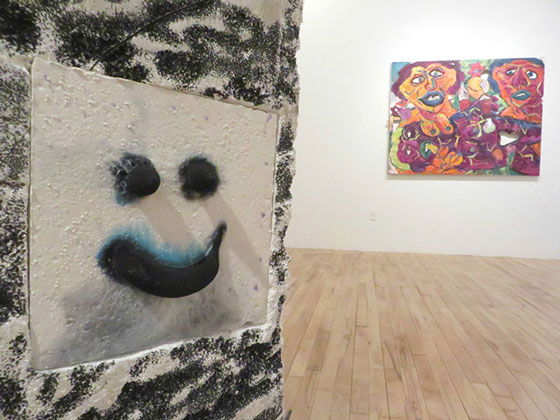
Jesse Patrick Martin (left) and Bryan Rogers (right) at Honey Ramka
Photo: Scott Robinson 2014
Stephen Eakin with Jesse Patrick Martin and Bryan Rogers
October 18th, 2014

To preface this interview, I will explain that I am familiar with the inception of Honey Ramka, and was curated into its initial show when it was in Suite 217. Since then I’ve gotten to know Jesse and Bryan as artists, curators, and friends. The interview is framed with questions, but acts as a meandering conversation about what it means to be an artist and gallerist. We talk about the logistics of operating a space, and the dynamic of providing fellow artists with a place to exhibit. Through their transparent explanation of how they came to be running Honey Ramka, there is a lot to learn for endeavoring artists, collectors, and gallerists alike.
-Stephen Eakin
Stephen Eakin: Let’s start with you explaining how Honey Ramka got started.
Jesse Patrick Martin: Alex Kaluzhsky and Polina Barskaya Kaluzhsky began the exhibition space Suite 217 in Jason Reyen's studio, upstairs in the 56 Bogart building—the same building we're in now. We were invited to help with a group show, 25 Artists, co-curated by Alex, Polina, and Heather Garland. We were also in the show and were asked to come in and help with the hanging because Bryan has experience doing that. And I helped make a book for it. Following that, we were asked to come on board and continue doing exhibits in that space.
Bryan Rogers: With Polina and Alex.
JPM: Yes with Polina and Alex - Suite 217. This was April of 2013. In retrospect, we can say that Suite 217 was the start of the gallery because we had a couple of other shows there—all groups shows, most notably a three-person exhibition with Linda Francis, John O’Connor, and Ken Weathersby.
It was Jason Reyen’s studio, and he liked what was happening. There was an opportunity to move into a space on the first floor, which has increasingly become mostly galleries. So we said sure, yeah, we want to continue doing this. And that’s when we opened Honey Ramka.
SE: So where does the name come from?
JPM: The shortest explanation is that at first it was sort of like “Brangelina”… an amalgamation of people’s names.
BR: Yeah, but it wasn’t really working. And between myself, Jesse, Polina and Alex, we were having a hard time coming to a consensus of what the name should be. We were at a restaurant eating food and came to Honey Ramka based on what we were eating…
SE: It’s the name of a dish?
JPM: No. It was Ethiopian food and they have honey wine.
BR: And Ramka was part of the original name-amalgamation.
JPM: But in Polish and Russian it means frame. And a honey frame is actually what beekeepers use to store honeycombs… but that’s not why –that’s just where we landed.
BR: It sounds like a person’s name and we liked that idea, and it kind of follows in the footsteps of spaces like Regina Rex.
JPM: People will often come in and ask, “Are you Honey? Who is Honey Ramka?” “He’s an eastern European pole dancer” is my favorite response. But it is definitely in the spirit of giving the gallery a person’s name.
SE: As practicing artists, how do you see running this space in relation to your practice?
BR: It kills it. Completely dead, gone. I

"Wretch" at Honey Ramka, Installation shot
Image courtesy of Honey Ramka
don’t really have a practice anymore, so I’ve just focused on the gallery. There’s curating group shows, but also curating the solo shows throughout the year and figuring out how they all work together. It’s pretty consuming.
SE: It’s two jobs.
JPM: Yes and since the original project, it evolved. It truly did. It changed into something unforeseen; a gallery with a program that moved into a larger space. It’s continued into year two and with that there’s been changes with the people involved. We’re learning as we go, as has everyone who’s been involved. Part of it is endurance. It’s kind of a logistical enterprise, one that requires all these things other than just hanging work on the wall. We’re continually challenged with the different facets of what it means to do this and to maintain it.
But we also are enjoying it. It continues to be interesting and challenging, which is what keeps me doing it. It remains engaging.
SE: Does it fill a need similar to your art practice?
BR: Kind of, I think if I was making work I would think about it differently.
JPM: When I was an undergrad, I was a painter. By my junior year I started doing site-specific installation with other people. That continued for a couple of years and projects became about how your work would fit in a context, whether it was an abandoned house or storefront or gymnasium. This feels like a continuation of that. It’s not about fitting my own work into this space, but it is about the project and how things work together and that conversation. It’s a different thing than making my own work, and independent from that. It’s been rewarding and interesting to have that excitement, and working with artists and having that conversation. There’s a bit of excitement that may be similar to an artist having his or her own show.
SE: So it sounds like, at least at this point, that it’s not feeding into your practice in any way.
JPM: No, it’s not. But it’s work you’re spending time with and reflecting on, and it inspires your work, or works against it.
SE: Since you’re spending so much time at it, how do you see the future of the space and its sustainability? How does the space sustain itself?
BR: This is an extension of Jason’s studio upstairs. He wanted to move downstairs, so he is still funding the space for us. He likes to be involved in the Bushwick art world, it makes him feel good, but he basically lets us do whatever we want with the space.
JPM: He’s entrusted us to develop the program as we see fit. It’s a conversation. We are very fortunate, but it’s strange in a way when describing this kind of experience.
BR: I wouldn’t even know how to tell somebody to go about it. In general I have an issue with seeking things out and making things happen, I think I just worked at art handling long enough, and stayed committed that I seemed valuable. That’s why I’m here now.
JPM: On my end, having worked in galleries and at art advisories, we have a skill-set that can make this happen.
BR: ...our goal is to sell work.
JPM: And we do!
BR: We’re working towards finding ways to meet more collectors and establish some

Jesse Patrick Martin (right) at Honey Ramka
Image courtesy of Honey Ramka
more relationships in addition to the ones we already have. We are applying to fairs to see how that goes.
SE: So you don’t formally represent artists right now?
BR: Well in applying to fairs you have to have some formal representation of artists. We’re happy to say that we’re now representing four artists, all of whom have had solo exhibitions at Honey Ramka: Ana Wieder-Blank, Jason Reyen, Lars van Dooren, and Elizabeth Ferry.
SE: It seems like, over time, through who you’re showing and what you’re showing, you’ll gain a certain reputation and you will have collectors as a result. It’s just a slow process.
JPM: Right. It seems like it should happen that way. As for the sustainability part of the question, it seems like everybody is aware of the model or the life of art neighborhoods. They happen at the time it’s inexpensive and artists move in. There’s development, a ground swell, and it reaches a critical mass. And the Yuppies come in and they buy everything and artists get pushed out. Is it happening in Bushwick? From all appearances the neighborhood is certainly changing.
BR: Jesse and I have lived in our apartment for 8 years now, so we’ve seen the change.
JPM: I’ve never lived some place where I’ve seen it change like this.
SE: Every time I come out here there’s a little bit more people, there’s a new restaurant or something. And I just live about a 10-minute bike ride away. Every time, it feels like a different place.
BR: It’s probably happening there as well.
SE: It is. We don’t have as many of the restaurants and cafés yet, but there are a lot of new condos popping up.
BR: Just give it time.
SE: Do you have any tips for anyone who might be looking to start up a space?
BR: There are so many models for it. It might be good to go around and look at what other people are doing and figure out what you can afford. If you want to work with other people and rent a space, that would probably be the smartest way to go about it. Get a bunch of people together, find an inexpensive space and go in together on it. If I were in a different situation and still interested in doing this, that’s the way I would go about it.
JPM: Galleries typically either own a space or rent a space, but there are a lot of spaces in a kind of transitional mode like unused storefronts.
BR: Minus Space started with a website. Then they moved from an online presence to an actual gallery.
SE: I want to know more about how you guys curate artists and select artists, given that there are two of you curating.
BR: We both went to grad school in different programs, so we have our own networks of people. And that’s where we’ve started. We still use our networks a lot, getting to know people through other people. If it’s a show like Wretch (a seven-artist figurative painting show that we kicked-off our second season with), it happened in an organic way.
SE: So in a group show there’s a kernel you’re starting with.
JPM: Basically. All the work in here comes from us wanting to do a figurative painting show. Most of the artists are basically in or around New York. We start with that broad concept and go from there, first looking at who is making figurative work.
"Not In My Backyard", Installation shot
Image courtesy of Honey Ramka

BR: And we think about the concept and who we can add to strengthen that concept.
JPM: Yes, and then it becomes about formal concerns. It becomes about how all this work is going to look together in this space and in this context—not that it overshadows other ideas, but how the work exists in this space is important.
SE: How should people find you if they’re interested in showing here?
BR: They should probably know us. For example, Elizabeth Ferry’s work—whose solo show, DEMS TOAD, is at the gallery now—when Yevgeniya Baras curated CAVING, a group show here last year.
JPM: We like that her work is kind of funny, and punk rock, and she has this talent to really cohere a show. So why not see how she shows on her own?
SE: Yes I really liked the image I saw on the press release for her show.
JPM: Those are rocks that are fluorescent, found underground and glow in the dark. They actually do that. It’s not a chemical additive. They have special properties. She has a light that helps them glow, that geologists use when they are looking for them.
JPM: But, it’s basically what artists can hold a show. There are plenty of artists making good work…
BR: Not that they couldn’t hold a show, but will the show fit in what we are trying to put together? What’s that show going to look like once we’ve done a lot of different shows one after another?
JPM: We all know the arts encompasses a broad range of practices, aesthetics, and materials, etc. We don’t want a program that is one-note.
SE: So you’re thinking about an overarching sense of the program. Instead of one show at a time, you’re planning across the whole year.
JPM: Yeah. And that sense of identity is something that forms over time. For many

Bryan Rogers (left) at Honey Ramka
Image courtesy of Honey Ramka
galleries, you can get a sense of their program through the artists that they show, but that doesn’t happen overnight. But there are galleries that have been around a long time and you still don’t get that sense.
BR: We like made things. That’s pretty definite.
SE: So object based… As opposed to your neighbors at Momenta, who have more performance and other less tangible shows.
BR: True, but we've shown installation and video and we definitely don't think about "can we sell this" when we put shows together. We've also held several performances, discussions, and other events at the gallery. We'll be taking part in Exchange Rates and hosting a London gallery in our project space, as well as hosting a book launch for Alexander Nemser's new publication, a Pratt panel discussion, and a dance performance by Matthew Rogers.
SE: So, for artists that like your program, they should do what?
JPM: We don’t really have an open submission policy. But when people come in, we tell them they can write their website down and we will look at it.
BR: And we do. We look at all of it.
JPM: There are times when we’ve done studio visits based on work we’ve just seen JPEGs of.
SE: So you kind of have to at least have a public presence?
JPM: But you know what though, it would be amazing to find out about somebody’s work and it’s a Darger-type moment where you find this treasure trove. That would be fantastic.
SE: But that artist is probably not going to approach you, or even be reading this interview. What about people who really like your space?
BR: Can they just contact you?
SE: Are you hiring me as a screener?

Jesse Patrick Martin at "Dems Toad" opening
Photo: Scott Robinson 2014
JPM: There’s that weird moment of being an artist and knowing the discomfort, and not having a map and a compass to approach a gallery. Except now I am on the other side of that and saying “oh here’s that moment”.
BR: I’ve never done that – just gone into a gallery and said, “Oh, hi, I’m an artist” so it’s weird for me to deal with that. But I can sympathize with it, and I am friendly and ask them to email me their website when they talk to me.
SE: Also, though, if they know the space, they know something about who you guys are, and hopefully know it’s just two people who have their hands full.
JPM: You would think that.
BR: We do try to look at a lot of things and now that it’s just Jesse and I it’s a little easier.
JPM: We’re a little more fleet footed because we’re partners and we know how to argue...
BR: Yeah, so we can work things out much farther in advance versus when you are in a collective and trying to meet…
JPM: It becomes a decision by committee a little bit more…
BR: … and it just takes longer.
SE: There was another interview where you referenced how exhibitions have the potential to push artists and change their work. Since you’ve been working with Honey Ramka, have you witnessed this with artists you’ve worked with?
JPM: That was probably Artfile. I think I remember that conversation, it was sort of about this being a new hat to wear for us.
BR: The interview was about a year ago and we had just moved into this space.
JPM: I think I was articulating that it was kind of a strange feeling to be in this position where we can offer this opportunity to show an artist’s work, which, as an artist, that seems like a validating moment: to be included in an exhibition.
BR: I don’t know if enough time has gone by to notice if any of the artists’ work has changed, but I have noticed if we give someone enough time to do a show, say six months, they’ll really step it up.
JPM: It gives artists an external goal, external to just making the work itself, which is something all artists are familiar with.
SE: I definitely agree with that, and I talk to people all the time about how having a deadline turns some adrenaline up. Having a space to plan for helps beyond just working in the studio. It’s a catch 22. You need enough work to get somebody on board with what you’re doing, but our studios are only so big. There's only so much you can store.
JPM: Right, however, the notion of validation in this way is problematic. Because certainly people making work, in and of itself, is validating and valid whether or not it’s being exhibited. But we still recognize it is a way to give a kind of wind beneath the wings or something like that. On top of that, I have seen that with several artists we’ve exhibited other galleries have seen their work and started showing them. It’s opened up a lot of opportunities (for them) –which is encouraging.
Yes. I think for better or worse we are a bit myopic. You have to be. And we are tending our garden so to speak. This is where we live and we’re fortunate to have this opportunity to do this in a place that we know.
BR: Definitely. After artists show here it seems like it gives them some confidence and things happen for them.
JPM: It’s nice to see a thing we’ve created getting reciprocated. It’s an interdependent endeavor. We’re keeping this thing going.
SE: So is that where you see this contributing to the arts community?
JPM: Yes. I think for better or worse we are a bit myopic. You have to be. And we are tending our garden so to speak. This is where we live and we’re fortunate to have this opportunity to do this in a place that we know.
BR: I used to have a studio upstairs; this is a building where I’ve really spent a lot of time.
JPM: It’s still Brooklyn. It’s a densely populated place where there’s a lot happening. And when you lose focus and can’t get a sense of the total picture, I think that’s a good example of a vibrant art scene. There’s just so much going on.
BR: We are also very lucky to be so close to these other galleries. They are very good and varied. They are all very serious and it encourages us to be more focused.
JPM: There’s also an understanding that this is migratory. And the people who are doing it –and continue to do it– they move and they change. It’s part passion project and that’s what it means to do it. If you’re doing it for the long game, you’re moving around.
BR: We’ll see. We might eat our words.
SE: And how do you feel about the idea of spaces at temporary projects? Does that mean they are failures? Can they be that way by design?
JPM: Well we saw what happened with the 17-17 Troutman building and the sort of ‘flushing’ of the galleries. Regina Rex landed on its feet.
SE: I think it pushed a lot of those spaces to reach a little higher. A lot of them moved to the Lower East Side and Chelsea.
BR: Yes, it’s definitely not a failure. Even if we don’t have a space, I’m sure we will continue to do other things and be involved in this way.
JPM: So far that seems to be the trajectory. Hindsight is 20/20 and looking back it’s crazy to retrace the steps of this space. But you can see it forming. It makes sense that it has come to this. We don’t have a crystal ball, but we are trying our best to keep it going and to learn what it means to keep it going. If it’s in this building, that’s great. The landlord is…
BR: Nice, he’s very nice. He’s great.
JPM: He seems to be invested in the idea of maintaining this, in contrast to 17-17 Troutman, where there was an attack on those spaces.
BR: Yes here they’ve really nurtured and developed having people in here.
JPM: And we’re not fools. As the neighborhood gets more on the map, we realize we’re just visitors. We’ll see. You just kind of have to roll with it and evolve.
Honey Ramka is an exhibition space directed by Jesse Patrick Martin and Bryan Rogers. The gallery is located in Bushwick, Brooklyn @ 56 Bogart Street (first floor).
Hours: 1-6pm on Fridays, Saturdays, Sundays, and by appointment
Stephen Eakin is an artist living and working in Brooklyn and contributes regularly to PAINTING IS DEAD.

"Twice Bitten", Installation shot
Image courtesy of Honey Ramka
Disclaimer: All views and opinions expressed are those of the authors and do not necessarily reflect the views of the editors, owner, advertisers, other writers or anyone else associated with PAINTING IS DEAD.
